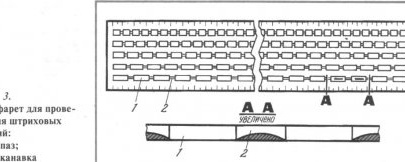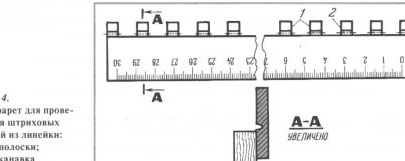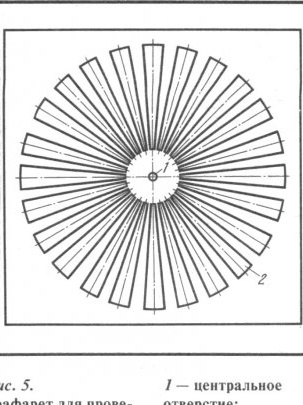Home page
1. Drawing board.
2. Inertial Drawing Tire.
3. Stencils for dashed lines.
4. Fixture for building tangents and normals to curved lines.
5. How to divide a line and a circle into equal and unequal parts.
Stencils for dashed lines.
The disadvantage of the usual simple ruler is the inconvenience of drawing dashed lines. The designer, plotting these lines, withstands the length of the strokes and the gaps between them "by eye", intuitively.
I propose to improve the usual drawing line and adapt it for drawing dashed lines. Or make a special stencil for these purposes. Maybe the idea of such a stencil was suggested to someone by a historical anecdote telling about a case that allegedly happened during the design of the railway from St. Petersburg to Moscow.
Having decided to connect the two capitals of Russia by rail, Emperor Nicholas I, who was an excellent draftsman and had a personal drawing tool, taking a ruler and a pencil, drew a straight line between the cities and ordered to build a railway exactly along it. However, in one place, because of the emperor’s finger protruding beyond the edge of the line, the pencil described a certain arc. So, they built a road along this line - a straight line, but with a bend in one section. The main conclusion from what happened is that if there are any obstacles in the way of the pencil, it is easy to change the type of line.
But back to our problem of drawing dashed lines. In the stencil-plate (Fig. 3), grooves are arranged in several rows. In each row, the grooves have their own length and pitch, which allows strokes of one or another standard size. The grooves in each row are interconnected by grooved grooves. The width of the grooves is usually 0.7 ... 1.5 mm, that is, corresponds to the diameter of the pencil core.
Click to enlarge.
The grooves are made somewhat narrower; they serve to “guide” the pencil from groove to groove. The bottom of the groove is performed with slopes in the direction of the grooves, which is necessary for the convenience of moving the pencil from one groove to another.
The draftsman selects the required line size (the required row of grooves), sets the ruler so that this row coincides with the direction of the drawn line, inserts a pencil into the first groove and leads it through all the grooves and grooves. It is clear that when a pencil passes through a groove, a stroke is drawn, and when moving along a groove, a gap is formed between the strokes. Drawing lasts a few fractions of a second, the complexity of drawing is minimal, the accuracy of strokes and spaces is high.
A good stencil is also obtained from the drawing line (Fig. 4). To do this, strips of thin sheet material are glued to the back of the ruler, placing them with a gap of 5 ... 7 mm. The width of the strips themselves is 1 ... 2 mm. Strips can be made with grooves (as in Fig. 4) or without the latter.
Click to enlarge.
Very tiring for the designer is the implementation of "dashed" circles. This work is called routine. Therefore, to draw such circles using an ordinary compass, I propose a special stencil (Fig. 5), which is made of thin material (plexiglass, sheet metal, etc.) with a thickness of 0.1 ... 0.3 mm. It is clear that the grooves in the form of sectors are cut in the stencil. The stencil is designed to hold circles with a diameter of 10 to 200 ... 300 mm. When working, the stencil is placed on the drawing, combining its central hole with the center of the future circle. Next, put the compass needle in the center of the stencil and conduct the stylus along the grooves, making 1 ... 2 turns.
Click to enlarge.
Drawing strokes is easy, with great productivity and minimal labor, because the length of the lines is maintained automatically. In addition, the larger the diameter of the circle, the greater the length of the strokes, which is what is required by the standard.
Content:
Home page
1. Drawing board.
2. Inertial Drawing Tire.
3. Stencils for dashed lines.
4. Fixture for building tangents and normals to curved lines.
5. How to divide a line and a circle into equal and unequal parts.



